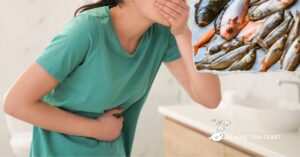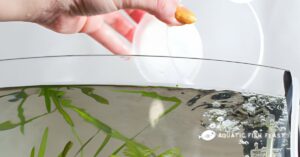Do you want to know the difference between fish feed and fish meal? From my experience, I can tell you that fish feed and fish meal are different.
To begin, fish food is any food meant to be eaten by fish. Conversely, fish feed is specifically designed to fulfill the dietary requirements of fish.
Live or frozen game items, as well as flakes, pellets, or gel foods made just for fish, can all be used as fish food.
Fish feed, on the other hand, is made by experts and scientists to meet the unique needs of fish in terms of protein, fat, and vitamin content.
That is, fish food is just anything that a fish can eat, while fish feed is food that has been specially made to give fish the nutrients they need.
But that’s not all. Please keep reading to learn more about how they are different.
Now, let’s get started.
Table of Contents
What Is Fish Feed And Fish Meal
An industrial product called fish meal is made from whole wild-caught fish, bycatch, and fish by-products. It is used to feed farm animals like pigs, chickens, and farmed fish.
Fishmeal has been very important in the growth of factory farms and the number of animals that can be raised and fed because it is cheap to make and has a lot of calories.
Fish meal comes in the form of a cake or a powder. To get this shape, the fish or fish pieces are dried and then ground up. It is first pressed to get the most fish oil out of a fish that is high in fat.
There are disagreements about how to make and use fishmeal on a big scale. Because the market for fishmeal as a feed is so profitable, corporate fisheries don’t limit the bycatch they catch.
This causes ecosystems to become depleted, damages the environment, and leads to the end of local fishing.
Groups that fight for animal rights and safety have also said that it is wrong that it helps factory farms breed and feed too many pigs and chickens.
Manufacturers of fishmeal say that the fact that fishmeal is used to feed and breed millions of farm animals means that more food is made, and millions of people worldwide are provided with it.
How Is Fish Meal Used
Until 1910, fish meal was mainly used as manure in the UK. Since then, its high nutritional value has been better used to feed animals.
It is much more popular in the UK to buy fish meal than to eat fish itself, so a lot of fish meal is brought into the UK from other countries.
The pig and chicken companies that make a lot of bacon and eggs (pork and chicken) at low prices would only be able to stay in business with many high-protein animal foods, like fish meal.
Most of the time, pigs and chickens eat about 10% of their food as fish meals. 10% is the most common meal that can contain 10% fat because giving an animal more than 1% fish oil may change the taste of its meat.
A lot of what is made in the UK is a white fish meal, which has so little fat that there is no risk of shame. It is sometimes possible to produce fish meals with very little fat for specific uses.
Mink, farmed fish, dogs, cats, and horses can all be fed fish meal, among other things.
Tiny amounts of carefully processed meals have been used to make foods for people, and fish meal is also used to make medicines for the pharmaceutical business.
What Is Fish Feed
Fish feeds are an essential component of both commercial and personal aquaculture to provide a nutritionally complete and well-balanced diet for fish that have been farmed.
The aquaculture feed is often in the shape of pellets or granules, and it delivers complete nutrition in a form that is both concentrated and stable.
This enables the fish to consume the feed effectively and reach their full growth potential.
Fish oil and fish meal make up a significant portion of the fish feed; these two components are then mixed with other necessary components such as minerals,
vitamins, cereal grains, and vegetable proteins to create granules or pellets. Fish oil and fish meal are the essential elements in fish feed.
What Ingredients Are Used For Fish Feed
Nowadays, more and more manufacturers are utilizing substances derived from plant and animal sources.
The depletion of resources brings about substantial change from fish oil and fish meal.
Since most fish are carnivores—including some found in freshwater lakes—they need diets high in fats and proteins and low in carbohydrates and fiber.
In contrast to their carnivorous counterparts, fish species classified as herbivorous and omnivorous primarily consume fish meals derived from plant materials, which enables them to digest starch more easily.
Ingredients derived from animals that are utilized to provide food for fish aquaculture include:
- LT1 fish meal
- Feather dinner
- The typical fish supper
- Red blood cell powder
- crimson meat
Plant-based components include:
- Fava or horse beans
- Soy-based
- Soy-based meal
- Concentrate on soy protein.
- Raphael
- meal made with rapeseed
- Cake with sunflowers
- Maize
- corn starch
- Green beans
- concentration of pea protein
- Wheat
- Middlings of wheat
- gluten from wheat
- Concentrate of Rice Protein
What Is The Benefits Of Fishmeal
Fishmeal improves nutrient uptake, digestion, and absorption while increasing feed efficiency and development through enhanced food palatability in animal diets.
Fishmeal’s balanced amino acid profile interacts with other animal and vegetable proteins to speed development and save feeding costs.
A balanced supply of all required amino acids, phospholipids, and fatty acids
(e.g., EPA or eicosapentaenoic acid and DHA or docosahexaenoic acid) Is provided by high-quality fishmeal for the best possible development, growth, and reproduction, particularly for larvae and broodstock.
The nutrients in fishmeal also support and maintain a strong, robust immune system, contributing to disease resistance.
Good fishmeal also makes it possible to create nutrient-dense meals that encourage the best potential growth.
Due to its higher nutritional digestibility, fishmeal added to the diets of aquatic animals helps lower contamination from wastewater effluent.
Adding premium fishmeal to feed gives the finished product a “natural or wholesome” quality, similar to what wild fish provide.
What Is The Main Difference Between Fish Food And Fish Feed
People often use the words “fish food” and “fish feed” to mean the same thing, but they can also mean slightly different things:
1. A meal for fish:
Most of the time, “fish food” means food made for tank fish or other decorative fish. It can be flakes, pellets, frozen, or live foods like brine prawns, among other things.
– Fish food for pets is usually made to fit each species’ dietary needs and tastes, considering things like size, color improvement, and nutritional needs.
2. Fish feed:
Usually, “fish feed” means the food used in aquaculture, which is the growing fish to eat. These can be fish like tilapia, salmon, catfish, and more.
– Fish feed for aquaculture is made in more significant amounts and is designed to help fish raised for business reasons grow quickly and stay healthy.
The food is usually in the form of pellets and has all the nutrients that bred fish need.
Final Thought
Now that we have established the difference between fish feed and fish meal. In summary, fish food is primarily intended for pet fish in aquariums.
It is customized to their unique needs, whereas fish feed is intended for commercially farmed fish and is designed to optimize growth and match the nutritional requirements of commercially farmed fish.




